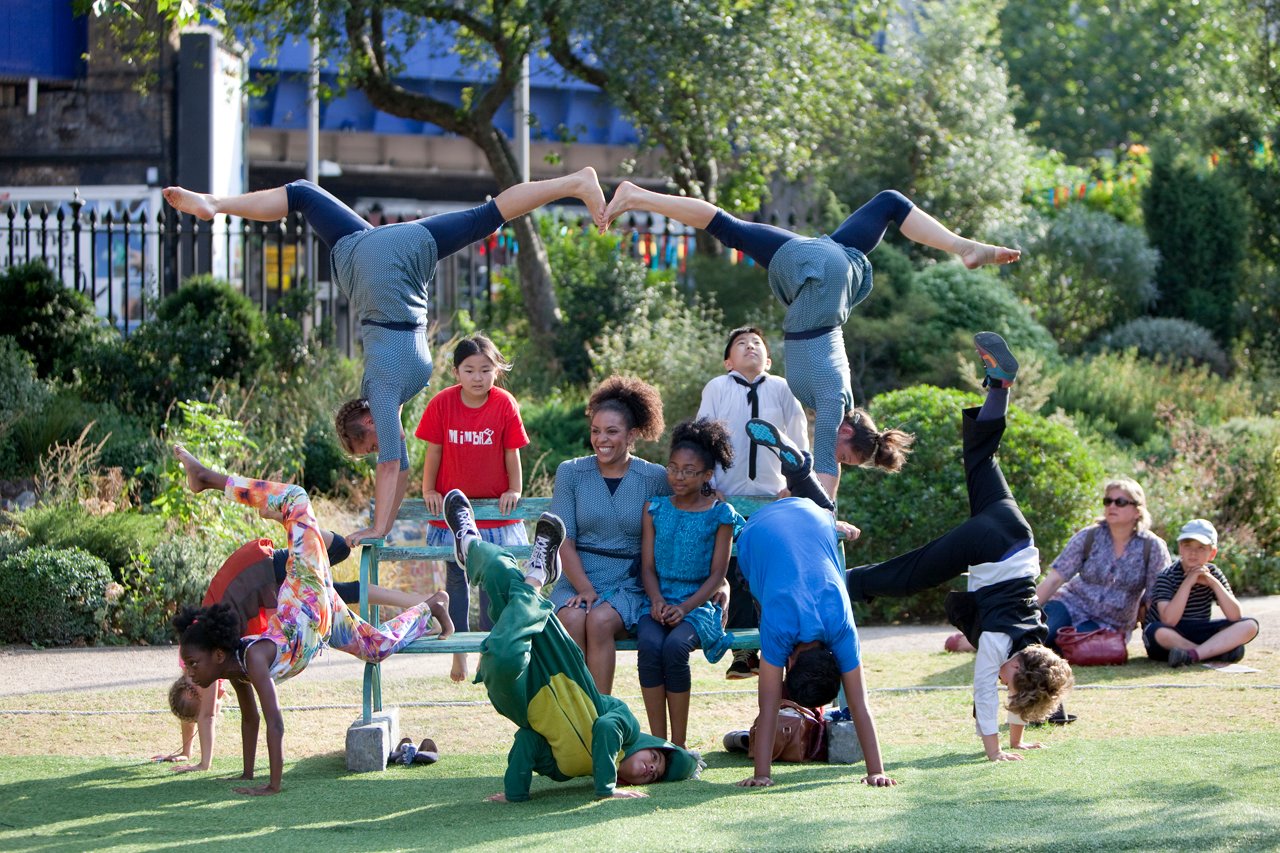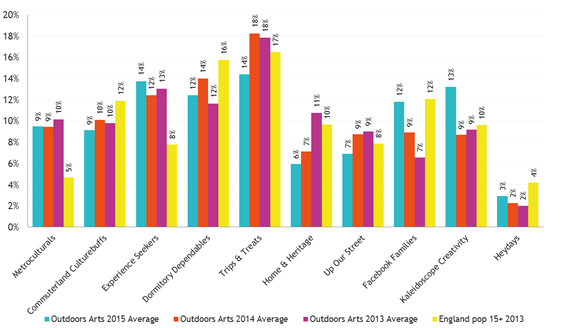
‘Bench’ by Mimbre
Photo: Ludovic des Cognets
Outdoor pursuits
The outdoor arts attract audiences that other artforms aren’t always able to. Jonathan Goodacre examines why.
The Audience Agency has recently completed a large-scale study into outdoor arts. Working in partnership with the Independent Street Arts Network and other organisations and consortia such as Xtrax, Without Walls, and Global Streets, we collected 30,000 surveys over three years, drawing data from over 40 arts organisations.
The findings are both fascinating and exciting. One of the most important findings is that outdoor arts consistently attract an audience that is representative of the population as a whole.
This is a simple statement with profound significance. In the cultural sector there’s often the ambition to be accessible for all, and there are examples of that being achieved. The outdoor arts though consistently achieve it over both time and place.
The graph below shows the Audience Spectrum profiles of outdoor arts attenders across the three years. What is noteworthy is the high proportion of attenders from the normally lower engaged groups such as Facebook Families and Kaleidoscope Creativity.

This is particularly relevant, given how hard other artforms work to attract these lower engaged groups. The range can be seen in other ways too: mosaic profiling, geographical spread and demographic characteristics.
Broad audiences
So what is it about outdoor arts that attracts such a broad audience? Is it as simple as the fact that they are free? Price incentives have not always worked at generating audiences across other areas of the sector, so it must be that there’s more to its success.
Outdoor arts are accessible to all because the barriers that some other artforms face (strict timings and buildings) do not exist. They offer social experiences that audiences enjoy. Results from our study show that the main motivations to attend outdoor arts are ‘to be entertained’, ‘to enjoy the atmosphere’, ‘to do something new or out of the ordinary’ and ‘to spend time with friends and family’.
We have seen ‘to be entertained’ as the main driver for attendance previously (discussed in an earlier article in AP), and outdoor arts supports this along with other factors including enjoying a special social experience. At most events audiences are given the freedom to roam around, join in when they want to and leave without feeling intimidated. They are in control of what and how much art they consume and engage with.
At most events audiences are given the freedom to roam around, join in when they want to and leave without feeling intimidated
Audiences for outdoor arts are overwhelmingly local, with 70% of people coming from within a 20-mile radius. The events generally take place in spaces that people know and are comfortable with; they tend to have strong associations with a place and can be an important part of placemaking and civic pride. Furthermore, because they’re often embedded in local communities, outdoor arts attract a broad range of people, and also provide performers and volunteers.
A quality experience
Outdoor arts are recognised for producing something surprising and unexpected. There is an appreciation of something never seen before, happening in unexpected places, such as in the middle of a town.
Communication with audiences is usually straightforward and to the point. Our study shows that the elements that are less highly regarded are the amount of information available, such as an explanation and context. Audiences love the work but they want to know more about it.
Finally, and arguably most importantly, outdoor arts consistently rates highly for quality of experience. A staggering 97% of people rated the quality of experience as ‘good’ or ‘very good’. This goes some way in positively answering the question whether outdoor arts audiences are actually experiencing good art.
This is just the beginning of what we now understand about the role of outdoor arts in the cultural sector and its fundamental importance to stakeholders and the general public. If we were all to regard breaking down barriers as fundamental to our role as arts professionals, then there is much to learn from outdoor arts.
Jonathan Goodacre is Regional Director East of The Audience Agency.
www.theaudienceagency.org
The full report of this study will be published at the end of June.
This article, sponsored and contributed by The Audience Agency, is in a series sharing insights into the audiences for arts and culture.
Join the Discussion
You must be logged in to post a comment.